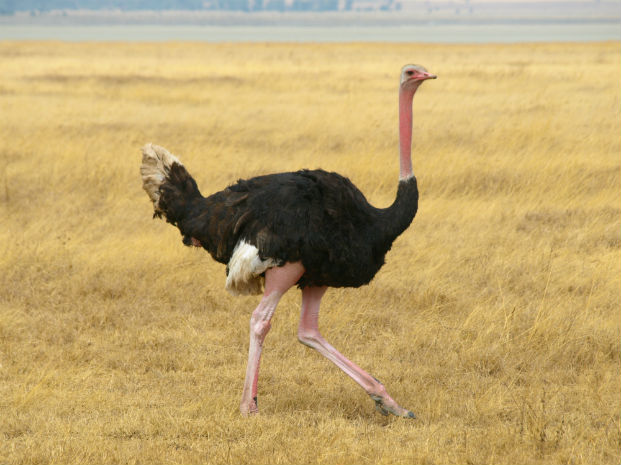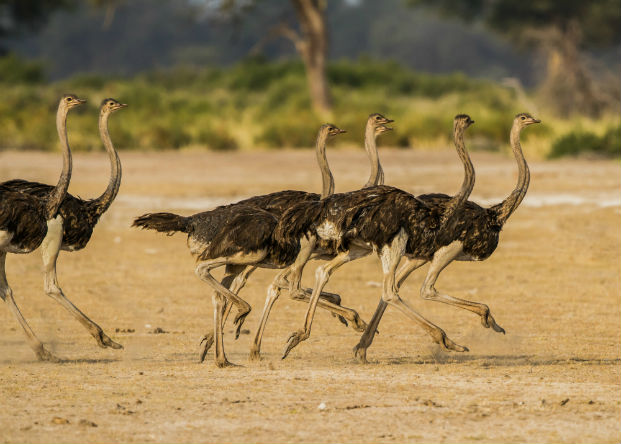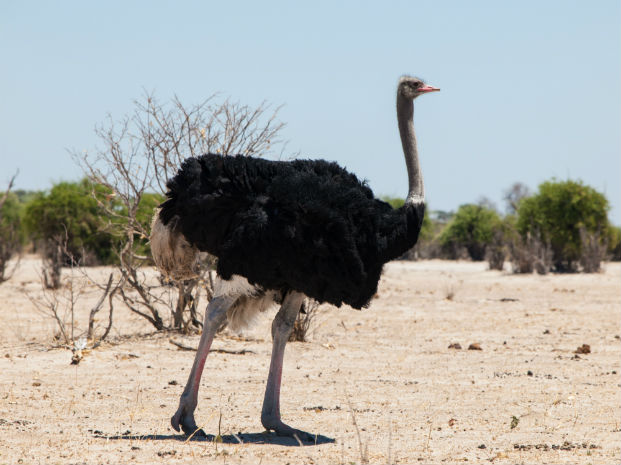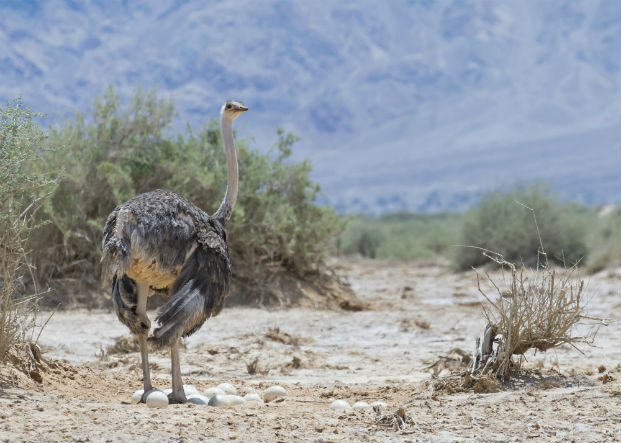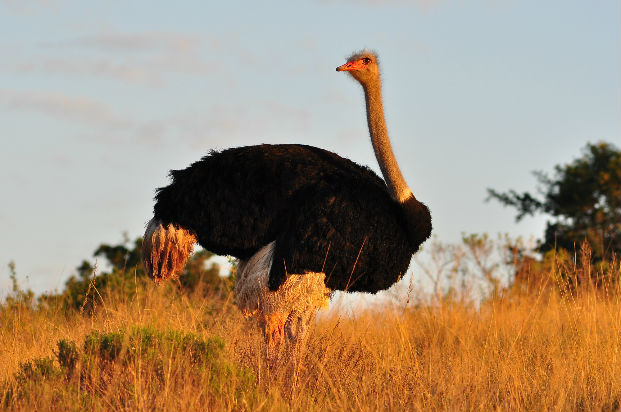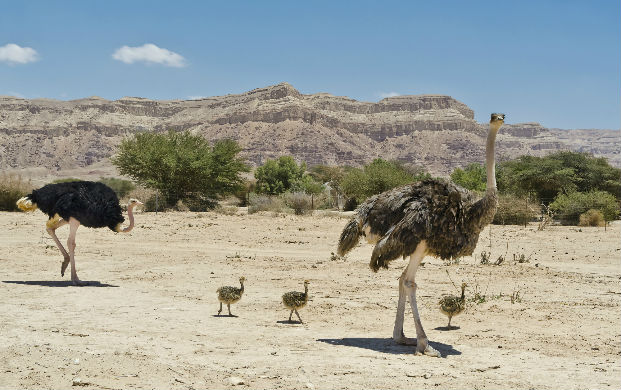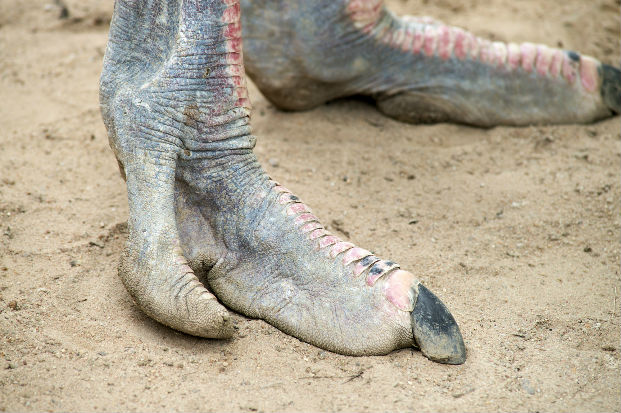
Unmistakable of all the bird species, the common ostrich is the largest and heaviest bird. Flightless, it occurs in savanna and semi desert plains, a habitat which it is most suited to given its long powerful legs which aid it to make a quick get a way when threatened.
Interesting facts about the ostrich
1. Number of toes
Whilst most birds have four toes the ostrich only has two, this appears to be an adaptation for running. However, they run on just one toe with the second being used for balance.
2. Roar
The booming call of the ostrich, which is made mainly at night, resembles a lion’s roar.
3. Mating dance
The males mating dance, known as “kantling”, is quite spectacular. They will approach the female with feathers raised before dropping to their knees and rocking from side to side as he waves his wings and twists his neck.
https://youtu.be/6H9Yt_ZrDIw
The ostrich mating dance is known as kantling. Video length: 2 minutes 30 seconds. Video source: Wild Planet
4. Eggs
Of up to 40 eggs laid (by 5 females) only half may be incubated as even an ostrich is not big enough to cover them all. Of these only 7.5 may hatch with a survival rate of just 12% due cold weather and predation by caracals, martial eagles and jackals.
5. Mass nest scrapes
5 female ostriches may lay their eggs in one scrape (nest) but only the major female incubates them. Being able to recognise her own eggs she ensures that they are in the centre. The rest will be moved to the side with many not be incubated.
6. Hatching
Because ostriches lack an egg tooth they have to rely on muscular spasms to break from their shells, this can take 9 hours. During this process they ingest part of the yolk sac which sustains them over the first 24 hours of life outside of the shell.
7. Eyes
At 5 cm wide, the ostrich has the largest eyeball of any land-living animal. This along with its long neck allows it to see over the long distances of its flat habitat.
8. Chicks
Chicks hatch with their eyes open and a coat of black tipped spiky down (fine fur) on their backs which makes them look like hedgehogs.
Ostrich: Frequently asked questions
- What is an ostrich?
- What is the scientific name of an ostrich?
- What types of ostrich are there?
- What habitat do ostriches live in?
- Can an ostrich fly?
- How tall is an ostrich?
- How heavy is an ostrich?
- What noise does an ostrich make?
- Can an ostrich roar like a lion?
- What is kantling?
- Vote for your favourite ostrich fact
What is an ostrich?
The common ostrich is a flightless bird that lives on the continent of Africa in savanna and semi desert plains. They are the largest and heaviest bird in the world and lay the largest eggs of any animal. They can run at over 40 mph.
What is the scientific name of an ostrich
The scientific name for the common ostrich is Genus: Struthio and specific name: camelus. This makes the binomial name for the ostrich Struthio camelus. Losely translated from ancient Greek the scientific name means thrush / sparrow camel.
what types of ostrich are there?
There are two species of ostrich, the common ostrich (Struthio camelus) and Somali ostrich (Struthio molybdophanes). Six other species are now extinct.
what habitat do ostriches live in?
Ostriches occurs in savanna and semi desert plains. Because the ostrich can’t fly it must run away from predators or other threats. The open habitat offered by savanna and desert allows the ostrich to reach its top speed of 43.5 mph unincumbered.
Can ostriches fly?
An ostrich does have a pair of wings but can’t fly. They are the largest and heaviest bird. They have strong powerful legs which can act as a weapon and enable them to quickly run away from danger. The world’s heaviest bird that can fly is the kori bustard.
How tall is an ostrich?
An ostrich is the largest bird in the world and is between 1.2 and 2m tall. The emu, native to Australia, is the second largest bird in the world at 1.5m tall. Like the ostrich they too are flightless.
How heavy is an ostrich?
An ostrich can weigh between 70 and 100kg and measures 1.2 to 2m in height. It is the heaviest bird in the world and is flightless. The heaviest bird than fly is the kori bustard weighing up to 19kg with a wing span of 2.5m.
What noise does an ostrich make?
Ostriches have a range of noises which they use to communicate, this includes chirps, honks, honks, hissing, grunting, drumming and booming. The hissing is the universally understood message of stay away. Booming is done by male ostriches during the mating season.
https://youtu.be/UW5HQZ_jRGY
A video complimation of the various noises that ostriches use to communicate. Video length: 1 minute 37 seconds. Video source: Rib Ticklers
Can an ostrich roar like a lion?
A male ostrich makes a booming sound during mating season. They inflate their neck up to three times the normal size. The booming may sound a little like the roar of a lion but it is not as strong. A lions roar can be 114 decibels travelling up to 8km.
The following video shows the mating call of a male ostrich – booming / roaring.
The booming of a male ostrich created by inflating its neck. Video length: 30 seconds. Video source: gggy1004
What is kantling?
Kantling is the spectacular mating dance of the male giraffe who approaches the female with feathers raised before dropping to their knees and rocking from side to side as he waves his wings and twists his neck. Video demonstrating the ostrich mating dance.
Vote for the fact you find most fascinating
Chicks hatch with their eyes open and a coat of black tipped spiky down (fine fur) on their backs which makes them look like hedgehogs.
The males mating dance, known as “kantling”, is quite spectacular. They will approach the female with feathers raised before dropping to their knees and rocking from side to side as he waves his wings and twists his neck.
Whilst most birds have four toes the ostrich only has two, this appears to be an adaptation for running. However, they run on just one toe with the second being used for balance.
Of up to 40 eggs laid (by 5 females) only half may be incubated as even an ostrich is not big enough to cover them all. Of these only 7.5 may hatch with a survival rate of just 12% due cold weather and predation by caracals, martial eagles and jackals.
At 5 cm wide, the ostrich has the largest eyeball of any land-living animal. This along with its long neck allows it to see over the long distances of its flat habitat.
Because ostriches lack an egg tooth they have to rely on muscular spasms to break from their shells, this can take 9 hours. During this process they ingest part of the yolk sac which sustains them over the first 24 hours of life outside of the shell.
The booming call of the ostrich, which is made mainly at night, resembles a lion’s roar.
5 female ostriches may lay their eggs in one scrape (nest) but only the major female incubates them. Being able to recognise her own eggs she ensures that they are in the centre. The rest will be moved to the side with many not be incubated.


